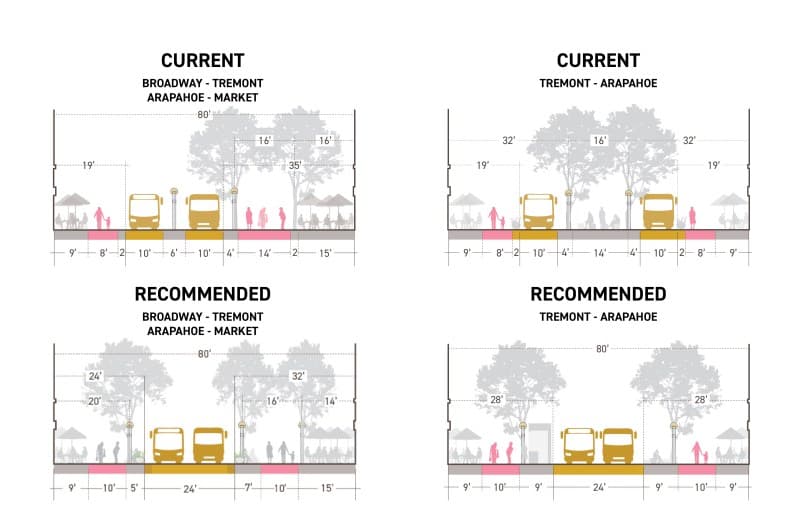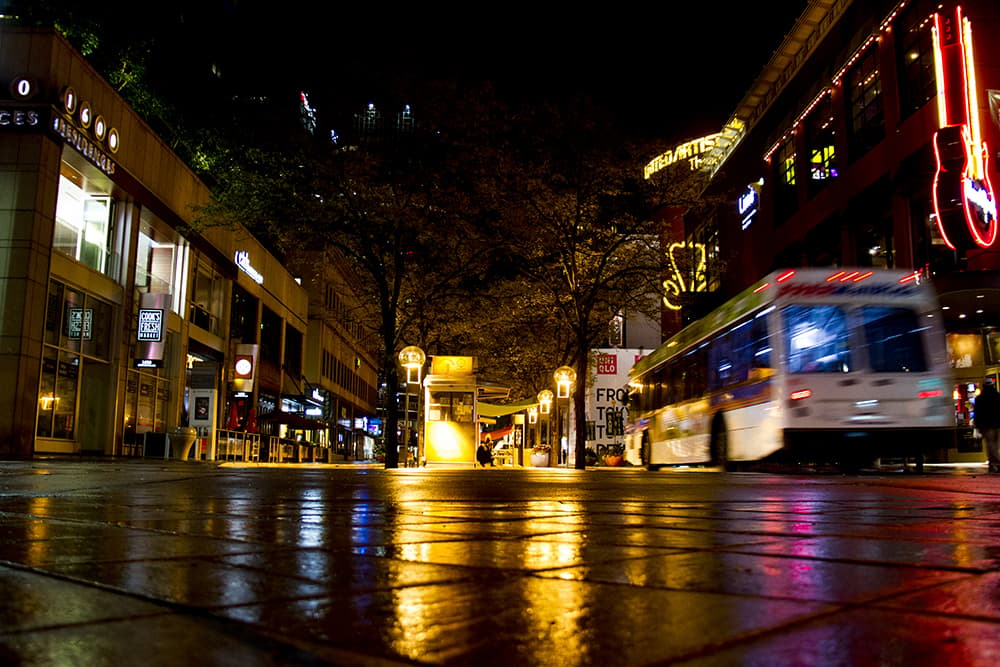A makeover of the 16th Street Mall took a major step forward Monday when the Denver City Council approved an agreement that funnels earmarked tax dollars into the project.
We've been hearing about changes coming to the 38-year-old walking, busing and Hard-Rocking street for a long time. Contractors, who have yet to be named, will repair the dilapidated and leaky pavement, which costs RTD about $1 million a year to maintain. Crews will also delete that thin pedestrian strip down the street's center and use the extra space to widen the sidewalks on either side. Bus shuttles will take over the middle of the street under which a water line from the 1800s will be replaced. New trees will dot the street where just seven of its 83 original oaks are still alive.

Estimates put the project cost between $90 million and $130 million, though city officials will not pinpoint a number, citing a competitive bidding process.
About $56 million of the pie will come from tax increment financing -- money siphoned from tax payments in various pockets of downtown in anticipation of higher real estate values down the road. While that money has already been collected by the Denver Urban Renewal Authority, it has not been obligated to the mall because the project is behind schedule and lacks detailed cost estimates. Monday's decision extended the deadline for committing those funds to 2022.
The council voted to advance the project by a vote of 11 to 1 with Councilwoman Candi CdeBaca dissenting. Councilwoman Debbie Ortega was absent.
In another world, Denver Public Schools and other corners of the city -- not the mall -- would rake in more than $50 million.
But in 2013, when given the choice to kill the special tax areas, created in the early 1990s, the city council kept them humming, said Tracy Huggins, executive director of the urban renewal authority.
So the money was diverted from DPS and the city's general fund long ago. But had legislators voted the other way, DPS, which faces a $65 million budget gap, would have received about $33 million in 2023 at the earliest. The city government, which faces a $226 million shortfall, would see about $23 million.
And some find that fact hard to swallow during a recession in a state that consistently ranks quite low in public school funding.
Paul Vranas, a parent of a DPS student who started an online petition against the funding tool that gained 3,000 signatures, said the choice was clear given the one-two punch of a budget shortfall and the Covid-19 crisis.
"Council is being asked tonight to take other people's money to fund a legacy project -- something we understand the attraction to," Vranas said. "However when you look at this project through the lens of our youth, the other people who you may be taking money from are the children of Denver."
CdeBaca voted against the extension in the name of DPS but also in the name of the city government, which could use the funding for housing and homelessness services. She said the conversation was not about taking money from schools and giving it to the mall; it was about seizing an opportunity to reconsider priorities.
"DPS and the city need it now more than ever," CdeBaca said, adding that a windfall like that "would be very helpful right now."
Councilman Kevin Flynn represents the city on the Denver Regional Council of Governments, which doles out federal funding to cities and counties. Flynn said Denver wrested $20 million for the mall from suburban officials "after substantial struggle and conflict."
"If this project were to be lost by voting no on the DURA amendment tonight, it would be more than another decade before the funding sources could be assembled again, if at all, while the mall would continue to deteriorate past its 50th year of service," Flynn said in a statement.
The mall makeover is a rehab project at its core, said Julie Smith, communications director for the city's finance office. But Mayor Michael Hancock's administration also wants it to boost local businesses and their employees.
Remember the study that claimed just 1 percent of people on the mall "linger" there? Sure, maybe it's because tourist shops and the Cheesecake Factory don't attract everyone, but planners say transience is a function of the space -- that more public space will mean more opportunities for lingerers. Lingerers mean consumers and consumers mean more money in the purses of business owners -- and the city itself in the form of taxes.
"The mall is just a critical artery for any downtown resident, for commuters, for transportation, for dining," said Craig Ward, who lives at the Spire building downtown. "It's basically a park ... and all residents treat it as such. I think that the city has a really important responsibility to invest in this part of the city."
Smith said the 1.2-mile-long street raises about $75 million a year for the city government, which can use that money on city services. The mall is responsible for about 1.5 percent of all the city's sales tax revenue and has the potential to take in more. Plus, Smith said the project itself will create about 1,500 good-paying jobs, mostly in the trades.
"That's a lot for a mile," Smith said.
Josh Laipply, the city's chief projects officer, argued that tax dollars will trickle down to funding for social services that others advocated for Monday. But opponents argued that money for DPS, which comes from real estate taxes, will only appear if and when the city recovers economically.













